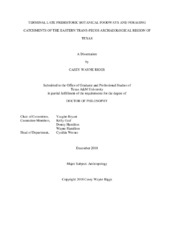| dc.description.abstract | By combining paleoethnobotanical data from nine archaeological sites in the eastern Trans-Pecos this dissertation identified the composition of plant diet for peoples between A.D. 1250 and 1535, here-in referred to as the Terminal Late Prehistoric and influenced by the Little Ice Age. This dietary makeup was then compared between the regional sites as well as to neighboring regions to the east, west, and north. A spatial model was also developed to identify reasoning for placement of open sites to access plant foods, explicate mobility patterns, and inventory other potential floral foods based upon ethnographic data.
A total of thirty-three botanical taxa were encountered from original and previous analyses primarily from macrobotanical, but also microbotanical, assemblages. Based upon assemblages from three rockshelters it was determined that a myriad of high, mid, and low ranked resources were utilized. These included agaves, mesquite bean pods, yucca fruit, prickly pear tunas, and forb seeds, primarily from the Amaranth Family. Small cacti, such as pitaya, and other forbs, such as purslane, also contributed heavily to diet but not to the degree of those previously mentioned.
When comparing plant diets to neighboring regions the study area was considered to have high commonality with the El Paso Phase, Ochoa Phase, and hunter-gatherer groups of the western Trans-Pecos due to occupancy of the Chihuauhan Desert. When archaeologically visible diet was compared to that of historic regionally recorded groups within the eastern Trans-Pecos there was high overlap between both. The one exception were low ranked forb seeds which the Terminal Late Prehistoric peoples may have used to a higher degree than later peoples.
The novel spatial model attempted to examine the landscape complexity as well as available dietary resources. Positive results demonstrated the validity of the model though calorie dense foods, such as piñon nuts, were gathered outside of the hypothesized forging catchments, likely indicating the use of a logistical mobility strategy specifically at Tranquil and Rough Cut Rockshelters. This analysis also indicated that some campsites, such as the Fulcher Site, were specifically located in order to access a diverse landscape with an even distribution of plant community patches. | en |


